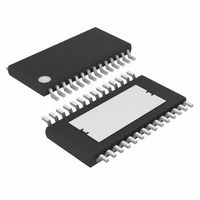MAX5051AUI+ Maxim Integrated Products, MAX5051AUI+ Datasheet - Page 17

MAX5051AUI+
Manufacturer Part Number
MAX5051AUI+
Description
IC PWR SPLY CNTRLR 28-TSSOP
Manufacturer
Maxim Integrated Products
Datasheet
1.MAX5051AUI.pdf
(21 pages)
Specifications of MAX5051AUI+
Pwm Type
Voltage Mode
Number Of Outputs
1
Frequency - Max
500kHz
Duty Cycle
48%
Voltage - Supply
11 V ~ 76 V
Buck
No
Boost
Yes
Flyback
Yes
Inverting
No
Doubler
No
Divider
No
Cuk
No
Isolated
Yes
Operating Temperature
-40°C ~ 125°C
Package / Case
28-TSSOP Exposed Pad, 28-eTSSOP, 28-HTSSOP
Frequency-max
500kHz
Lead Free Status / RoHS Status
Lead free / RoHS Compliant
The integrating fault protection feature allows transient
overcurrent conditions to be ignored for a programmable
amount of time, giving the power supply time to behave
like a current source to the load. This can
happen, for example, under load-current transients when
the control loop requests maximum current to keep the
output voltage from going out of regulation. The fault
integration time can be programmed externally by con-
necting a suitably sized capacitor to the FLTINT pin.
Under sustained overcurrent faults, the voltage across
this capacitor is allowed to ramp up towards the FLTINT
shutdown threshold (2.9V, typ). Once the threshold is
reached, the power supply shuts down. A high-value
bleed resistor connected in parallel with the FLTINT
capacitor allows it to discharge towards the restart
threshold (1.8V, typ). Once this threshold is reached, the
supply restarts with a new soft-started cycle.
Note that cycle-by-cycle current limiting is provided at
all times by CS with a threshold of 154mV (typ). The
fault integration circuit works by forcing a 90µA current
out of FLTINT every time that the current-limit compara-
tor (Figure 1, CILIM) is tripped. Use the following formu-
la to calculate the value of the capacitor necessary for
the desired shutdown time of this circuit.
where I
tion time after the first shutdown cycle during which
current-limit events from the current-limit comparator
are ignored. For example, a 0.1µF capacitor gives a
fault integration time of 2.25ms.
Some testing may be required to fine-tune the actual
value of the capacitor. To calculate the required bleed
resistance R
where t
Typically choose t
range from a few hundred microseconds to a few mil-
liseconds.
Figure 7 shows the connection diagram of two or more
MAX5051s for synchronized primary-side operation.
The common connection of STARTUP ensures all paral-
leled modules wakeup and shutdown in tandem. This
Synchronizing Primary-Side STARTUP For
RT
FLTINT
is the desired recovery time.
FLTINT
R
= 90µA, t
FLTINT
C
FLTINT
______________________________________________________________________________________
RT
, use the following formula:
Integrating Fault Protection
= 10 x t
=
SH
0 372
=
.
I
FLTINT
is the desired fault integra-
SH
. 0 9
×
t
RT
. Typical values for t
Parallel Operation
C
Parallelable, Clamped Two-Switch
V
FLTINT
t
SH
Power-Supply Controller IC
SH
helps prevent startup conflicts when the secondaries of
the power supplies are paralleled. Connecting
SYNCOUT to SYNCIN is not necessary; however, when
used, this minimizes the ripple current though the input
bypass capacitors.
Figure 8 shows a complete design of an isolated syn-
chronously rectified power supply with a 36V to 72V
telecom voltage range. This power supply is fully pro-
tected and can sustain a continuous short circuit at its
output terminals. Figures 9 though 14 show some of the
performance aspects of this power-supply design. This
circuit is available as a completely built and tested
evaluation kit.
Figure 7. Connection for Synchronized STARTUP of Two or
More MAX5051s
Isolated Telecom Power Supply
Applications Information
RCOSC
SYNCOUT
RCFF
CON
RCOSC
SYNCOUT
RCFF
CON
#1
#2
MAX5051
MAX5051
STARTUP
STARTUP
SYNCIN
SYNCIN
FLTINT
FLTINT
UVLO
UVLO
17












